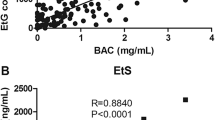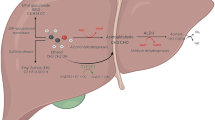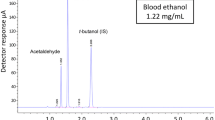Abstract
Postmortem ethanol formation is a well-known problem in forensic toxicology. The aim of this study was to interpret findings of ethanol in blood, in a large collection of forensic autopsy cases, by use of the nonoxidative ethanol metabolites, ethyl glucuronide (EtG), and ethyl sulfate (EtS). In this study, according to previously published literature, antemortem ethanol ingestion was excluded in EtS-negative cases. Among 493 ethanol-positive forensic autopsy cases, collected during the study period, EtS was not detected in 60 (12 %) of the cases. Among cases with a blood alcohol concentration (BAC) of ≤0.54 g/kg, antemortem ethanol ingestion was excluded in 38 % of the cases, while among cases with a BAC of ≥0.55 g/kg, antemortem ethanol ingestion was excluded in 2.2 % of the cases. For all cases where ethanol was measured at a concentration >1.0 g/kg, EtS was detected. The highest blood ethanol concentration in which EtS was not detected was 1.0 g/kg. The median concentrations of EtG and EtS in blood were 9.5 μmol/L (range: not detected (n.d.) 618.1) and 9.2 μmol/L (range: n.d. 182.5), respectively. There was a statistically significant positive correlation between concentration levels of ethanol and of EtG (Spearman’s rho = 0.671, p < 0.001) and EtS (Spearman’s rho = 0.670, p < 0.001), respectively. In conclusion, this study showed that in a large number of ethanol-positive forensic autopsy cases, ethanol was not ingested before the time of death, particularly among cases where ethanol was present in lower blood concentrations. Routine measurement of EtG and EtS should therefore be recommended, especially in cases with BAC below 1 g/kg.
Similar content being viewed by others
References
Baranowski S, Serr A, Thierauf A, Weinmann W, Grosse PM, Wurst FM, Halter CC (2008) In vitro study of bacterial degradation of ethyl glucuronide and ethyl sulphate. Int J Legal Med 122:389–393
Blackmore DJ (1968) The bacterial production of ethyl alcohol. J Forensic Sci Soc 8:73–78
Bosma PJ, Chowdhury JR, Bakker C, Gantla S, de Boer A, Oostra BA, Lindhout D, Tytgat GN, Jansen PL, Oude Elferink RP (1995) The genetic basis of the reduced expression of bilirubin UDP-glucuronosyltransferase 1 in Gilbert's syndrome. N Engl J Med 333:1171–1175
Boumba VA, Ziavrou KS, Vougiouklaksis T (2008) Biochemical pathways generating post-mortem volatile compounds co-detected during forensic ethanol analyses. Forensic Sci Int 174:133–151
Boumba VA, Economou V, Kourkoumelis N, Gousia P, Papadopoulou C, Vougiouklaksis T (2012) Microbial ethanol production: experimental study and multivariate evaluation. Forensic Sci Int 215:189–198
Canfield DV, Kupiec T, Huffine E (1993) Postmortem alcohol production in fatal aircraft accidents. J Forensic Sci 38:914–917
Fox IJ, Chowdhury JR, Kaufman SS, Goertzen TC, Chowdhury NR, Warkentin PI, Dorko K, Sauter BV, Strom SC (1998) Treatment of the Crigler-Najjar syndrome type I with hepatocyte transplantation. N Engl J Med 338:1422–1426
Gilliland MG, Bost RO (1993) Alcohol in decomposed bodies: postmortem synthesis and distribution. J Forensic Sci 38:1266–1274
Halter CC, Laengin A, Al-Ahmad A, Wurst FM, Weinmann W, Kuemmerer K (2009) Assessment of the stability of the ethanol metabolite ethyl sulfate in standardised degradation tests. Forensic Sci Int 186:52–55
Helander A, Bottcher M, Fehr C, Dahmen N, Beck O (2009) Detection times for urinary ethyl glucuronide and ethyl sulfate in heavy drinkers during alcohol detoxification. Alcohol Alcohol 44:55–61
Helander A, Olsson I, Dahl H (2007) Postcollection synthesis of ethyl glucuronide by bacteria in urine may cause false identification of alcohol consumption. Clin Chem 53:1855–1857
Hoiseth G, Karinen R, Christophersen A, Morland J (2010) Practical use of ethyl glucuronide and ethyl sulfate in postmortem cases as markers of antemortem alcohol ingestion. Int J Legal Med 124:143–148
Hoiseth G, Karinen R, Christophersen AS, Olsen L, Normann PT, Morland J (2007) A study of ethyl glucuronide in post-mortem blood as a marker of ante-mortem ingestion of alcohol. Forensic Sci Int 165:41–45
Hoiseth G, Karinen R, Johnsen L, Normann PT, Christophersen AS, Morland J (2008) Disappearance of ethyl glucuronide during heavy putrefaction. Forensic Sci Int 176:147–151
Hoiseth G, Morini L, Polettini A, Christophersen A, Morland J (2009) Blood kinetics of ethyl glucuronide and ethyl sulphate in heavy drinkers during alcohol detoxification. Forensic Sci Int 188:52–56
Hoiseth G, Yttredal B, Karinen R, Gjerde H, Christophersen A (2010) Levels of ethyl glucuronide and ethyl sulfate in oral fluid, blood, and urine after use of mouthwash and ingestion of nonalcoholic wine. J Anal Toxicol 34(2):84–88
Hoiseth G, Bernard JP, Karinen R, Johnsen L, Helander A, Christophersen A, Morland J (2007) A pharmacokinetic study of ethyl glucuronide in blood and urine: applications to forensic toxicology. Forensic Sci Int 172:119–124
Jones AW, Andersson R, Sakshaug J, Morland J (1991) Possible formation of ethanol in postmortem blood specimens after antemortem treatment with mannitol. J Anal Toxicol 15:157–158
Kristoffersen L, Stormyhr LE, Smith-Kielland A (2006) Headspace gas chromatographic determination of ethanol: the use of factorial design to study effects of blood storage and headspace conditions on ethanol stability and acetaldehyde formation in whole blood and plasma. Forensic Sci Int 161:151–157
Kugelberg FC, Jones AW (2007) Interpreting results of ethanol analysis in postmortem specimens: a review of the literature. Forensic Sci Int 165:10–29
Kuhlman JJ Jr, Levine B, Smith ML, Hordinsky JR (1991) Toxicological findings in Federal Aviation Administration general aviation accidents. J Forensic Sci 36:1121–1128
Levine B, Smith ML, Smialek JE, Caplan YH (1993) Interpretation of low postmortem concentrations of ethanol. J Forensic Sci 38:663–667
Mayes R, Levine B, Smith ML, Wagner GN, Froede R (1992) Toxicologic findings in the USS Iowa disaster. J Forensic Sci 37:1352–1357
O'Neal CL, Poklis A (1996) Postmortem production of ethanol and factors that influence interpretation: a critical review. Am J Forensic Med Pathol 17:8–20
Rainio J, Ahola S, Kangastupa P, Kultti J, Tuomi H, Karhunen PJ, Helander A, Niemela O (2014) Comparison of ethyl glucuronide and carbohydrate-deficient transferrin in different body fluids for post-mortem identification of alcohol use. Alcohol Alcohol 49:55–59
Rainio J, Kultti J, Kangastupa P, Tuomi H, Ahola S, Karhunen PJ, Helander A, Niemela O (2013) Immunoassay for ethyl glucuronide in vitreous humor: a new tool for postmortem diagnostics of alcohol use. Forensic Sci Int 226:261–265
Schloegl H, Rost T, Schmidt W, Wurst FM, Weinmann W (2006) Distribution of ethyl glucuronide in rib bone marrow, other tissues and body liquids as proof of alcohol consumption before death. Forensic Sci Int 156:213–218
Thierauf A, Kempf J, Perdekamp MG, Auwarter V, Gnann H, Wohlfarth A, Weinmann W (2011) Ethyl sulphate and ethyl glucuronide in vitreous humor as postmortem evidence marker for ethanol consumption prior to death. Forensic Sci Int 210:63–68
Thierauf A, Serr A, Halter CC, Al-Ahmad A, Rana S, Weinmann W (2008) Influence of preservatives on the stability of ethyl glucuronide and ethyl sulphate in urine. Forensic Sci Int 182:41–45
Wurst FM, Schuttler R, Kempter C, Seidl S, Gilg T, Jachau K, Alt A (1999) Can ethyl glucuronide be determined in post-mortem body fluids and tissues? Alcohol Alcohol 34:262–263
Acknowledgments
The authors are grateful to Stine Marie Havig and Veronica Liane for their assistance with the manuscript.
Author information
Authors and Affiliations
Corresponding author
Rights and permissions
About this article
Cite this article
Krabseth, H., Mørland, J. & Høiseth, G. Assistance of ethyl glucuronide and ethyl sulfate in the interpretation of postmortem ethanol findings. Int J Legal Med 128, 765–770 (2014). https://doi.org/10.1007/s00414-014-1031-z
Received:
Accepted:
Published:
Issue Date:
DOI: https://doi.org/10.1007/s00414-014-1031-z




